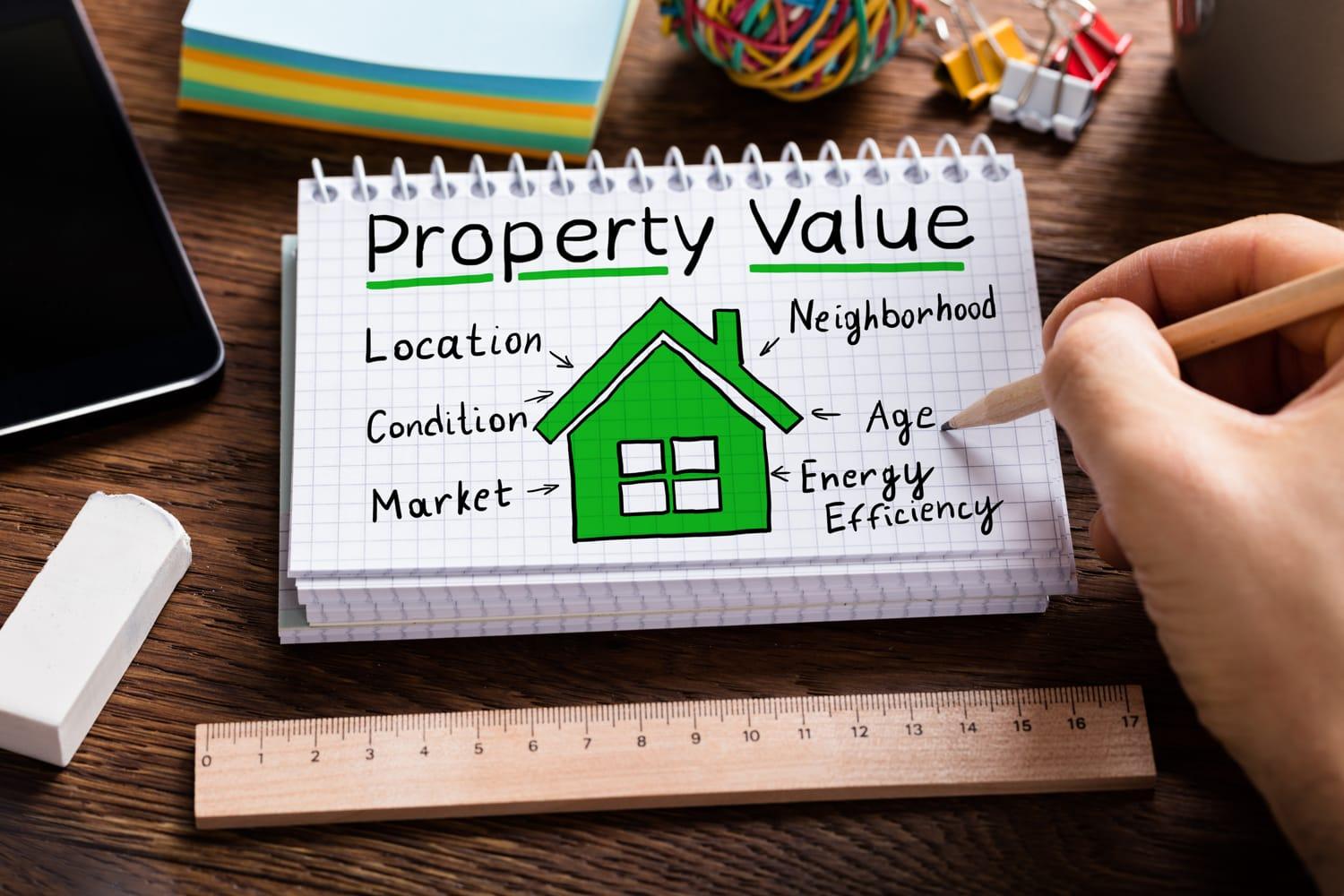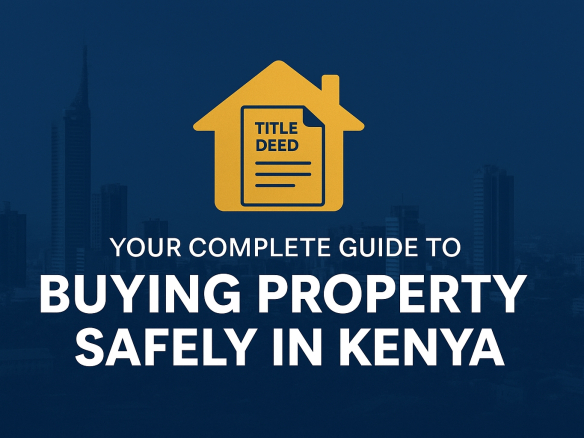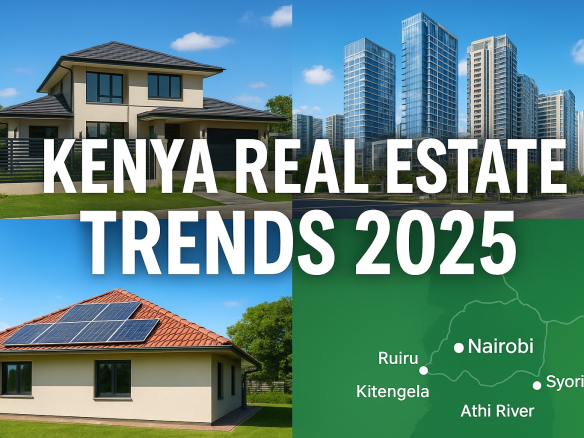Value vs Price in Real Estate: Is the Value of a Property the Same as the Selling Price?
When buying or selling real estate in Kenya, many people confuse value with price — but these two concepts differ significantly. Understanding the difference can help you make smarter decisions whether you’re purchasing a home in Nairobi, investing in a rental property, or selling land in Mombasa.

What Is the Price of a Property?
The price of a property is the amount of money a buyer agrees to pay and a seller agrees to accept. It is the actual selling price or listing price, influenced by:
Current real estate market trends in Kenya
Supply and demand dynamics in cities like Nairobi, Kisumu, or Eldoret
Negotiations between buyers and sellers
The seller’s urgency or buyer’s eagerness
Marketing strategies and property presentation
For example, a house in Nairobi’s Karen neighborhood might be listed at KES 50 million, which is the asking price and eventually sell at KES 45 million.
What Is the Value of a Property?
The value reflects the intrinsic worth of the property, based on objective factors such as:
Location desirability (proximity to schools, hospitals, business centers)
Property size, design, and condition
Local infrastructure and development plans
Comparable sales (comps) in the neighborhood
Potential for appreciation or rental income
A property valuer typically estimates this value using professional methods.
Other Forms of Value in Real Estate
Understanding the multiple facets of value can provide deeper insights:
Market Value: What a typical buyer would pay in the current market.
Investment Value: Value based on rental yields or future capital gains.
Use Value: Worth based on current or intended use (e.g., residential, commercial).
Emotional Value: Sentimental attachment that may increase price beyond market norms.
Replacement Value: Cost to rebuild the property at today’s prices.
Assessed Value: Value used by local authorities to calculate property taxes.
Liquidation Value: Likely sale price in a quick-sale situation.
Price vs Value: How Are They Different?
| Aspect | Value | Price |
|---|---|---|
| Definition | Intrinsic worth based on objective data | The actual amount paid or listed |
| Stability | More stable over time | Fluctuates based on negotiation |
| Determined by | Market analysis, physical property traits | Buyer-seller agreement, market demand |
| Influences | Location, condition, potential | Timing, urgency, emotions |
Is the Value the Same as the Selling Price?
Not always. For example, in a hot Nairobi real estate market, properties might sell above their assessed or market value due to high demand. Conversely, during slow economic times, prices may fall below intrinsic value.
How to Compare Value and Price When Buying or Selling Property in Kenya
1. Hire a Professional Property Valuer
Look for licensed valuers in Kenya who follow standards set by the Institute of Surveyors of Kenya (ISK) or relevant bodies. They’ll provide a valuation report based on:
Comparative Market Analysis (CMA)
Income Capitalization Approach (for rental properties)
Cost Approach (replacement cost minus depreciation)
2. Research Market Trends
Use local real estate platforms in Kenya to check recent selling prices and market movement.
3. Assess the Property Condition
Properties requiring renovations might have a lower market price than their value once fixed up.
4. Consider Long-Term Potential
Areas with upcoming infrastructure projects (like new highways or business hubs) often see values rise over time.
Why Knowing the Difference Between Value and Price Matters
For Buyers: Avoid paying more than a property is worth.
For Sellers: Price your property competitively to attract serious buyers.
For Investors: Identify properties with strong value but undervalued prices.
For Lenders: Banks rely on valuations to decide mortgage amounts.
Understanding that value and price are not always the same helps you make informed decisions in Kenya’s dynamic real estate market. Whether you’re eyeing a home in Nairobi, a commercial plot in Mombasa, or an investment property in Nakuru, always start with a professional valuation and market research before setting or accepting a price.
Sellers may aim to set a competitive price while emphasizing the unique qualities that contribute to a property’s value. Conversely, buyers must look beyond the sticker price, considering long-term implications like neighborhood developments and market trends. This perspective can be summarized in key points like:
- Market Trends: Frequently shifting and can influence price but not necessarily value.
- Location: Frequently enough a driving factor for both price and value, but its significance can differ.
- Property Condition: A well-maintained home may hold more value then a neglected one, irrespective of price.
| Aspect | Price | value |
|---|---|---|
| Definition | current market cost | Emotional and practical worth |
| Influencing Factors | Demand and supply, economic trends | Location, condition, emotional attachment |
| Stability | Variable and reactionary | Typically slower to change |

How Price Influences Perceived Value
In the realm of real estate, the interplay between price and perceived value is pivotal. Buyers frequently enough equate higher prices with superior quality, which can skew their assessments of a property’s true worth. This phenomenon can be attributed to several factors, including market trends, neighborhood dynamics, and property features. By skewing perceptions, pricing can create a psychological barrier that affects purchasing decisions. As a notable example, a listing that is strategically priced just below a significant round number can lead to increased interest and a perceived greater value among prospective buyers, despite no tangible differences in the property’s attributes.
Moreover, understanding how price fluctuations relate to perceived value enables real estate professionals to craft compelling narratives around listings. Factors contributing to this relationship include:
- Market demand: High demand often drives prices upward, enhancing perceived value.
- Comparable sales: recent sales nearby can establish a price benchmark that influences buyer expectations.
- Property enhancements: upgrades and renovations can significantly adjust perceived value despite minimal changes in actual cost.
To illustrate this relationship, consider the following table showcasing how specific features influence both price and value perception:
| Feature | Influencing Price | Impact on Perceived Value |
|---|---|---|
| Swimming Pool | +15% | High |
| Upgraded Kitchen | +10% | Very high |
| Energy-Efficient Windows | +5% | Moderate |
| New Roof | +8% | High |
Ultimately, recognizing these dynamics allows sellers and agents to navigate the complex landscape of real estate effectively. By aligning pricing strategies with perceived value, they can optimize outcomes in a competitive market.

Evaluating Properties: Key Factors Beyond Numbers
When assessing real estate, it’s essential to look beyond mere figures and consider a variety of qualitative factors that can significantly influence a property’s appeal and long-term value. Here are some vital elements to take into account:
- Location: Proximity to schools, parks and workplaces can enhance desirability.
- Aesthetics: Curb appeal and architectural style can impact first impressions and buyer interest.
- Community: The sense of belonging and the strength of local networks can add intangible value.
- Condition: Ongoing maintenance and potential renovation needs affect both livability and resale prospects.
Furthermore, it’s crucial to consider broader economic indicators and market dynamics that may not directly reflect in the asking price but still play a significant role in a property’s true worth. Key aspects include:
| Factor | Description |
|---|---|
| Market Trends | Fluctuations in local demand and supply influence overall value. |
| Neighborhood Growth | Upcoming developments can signal rising property values. |
| Rental Demand | High rental interest can enhance investment potential. |
Clearly evaluating these elements can provide a more robust understanding of what a property is genuinely worth, far beyond its current price tag. Delving into these factors not only helps buyers make more informed decisions but also equips sellers with the knowledge to price their properties effectively.

Making Informed Decisions: Strategies for Assessing Real estate Worth
The true worth of real estate transcends the numbers on a price tag. To gauge value accurately, one must adopt a multifaceted approach, analyzing both tangible and intangible elements. Location remains paramount; properties in developed, accessible areas typically command higher values. Comparable sales in the neighborhood provide a baseline for what similar homes have achieved. Additional factors such as the property’s condition, local market trends, and economic indicators also play crucial roles in determining worth. Creating a checklist that includes these elements can guide you as you research and compare potential investments.
Engaging with professionals can further enrich your assessment process. Real estate agents bring local expertise, while appraisers can offer unbiased evaluations reflecting market conditions. Additionally, utilizing online tools and databases can enhance your understanding of current pricing trends. Bringing all these insights together allows for a comprehensive view of real estate worth. Below is a simple table that outlines essential factors in determining property value:
| Factor | Description |
|---|---|
| Location | Proximity to amenities, schools and transport links. |
| Comparable Sales | Sales data of similar properties in the area. |
| Property Condition | State of repairs, upgrades, and overall appeal. |
| Market Trends | Current economic climate and forecasted changes. |




Join The Discussion